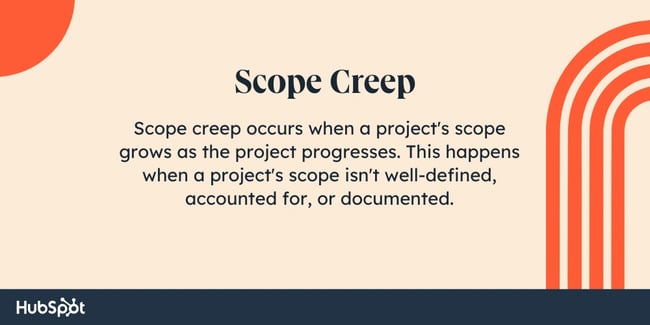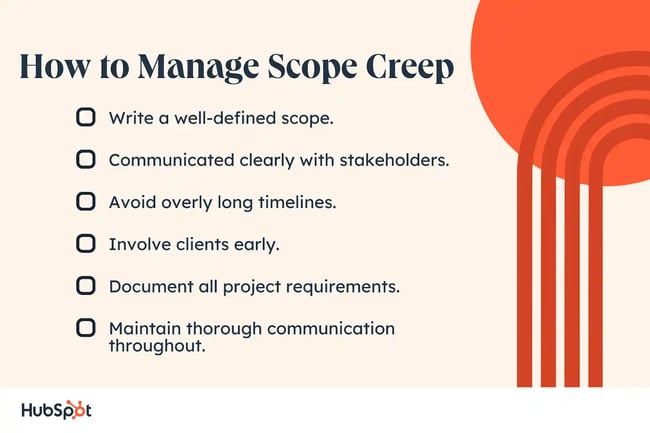Table of Contents
Before you can have a firm grasp on scope creep as a concept, you need to understand what scope is in the first place. Essentially, scope clearly defines the “who, what, when, and how” of a project. In project management, there are two primary kinds of scope — product and project.

Product scope refers to the ideal sum of functions and features that a project will produce for a given product. Project scope is the understanding of the work that an organization needs to do to deliver those functions and features.
Scope creep occurs when stakeholders wind up adding additional functions, features, requirements, or other unauthorized work as a project progresses. It often leads to problems like inefficiency, incomplete projects, running over budget, unnecessary time drain, and products that don‘t reflect plans or clients’ requests.
Causes for Scope Creep
1. Lack of a Well-Defined Scope
Structure and clarity are central to effective project management — and essential when it comes to avoiding scope creep. If a project‘s scope isn’t clearly established, then it falls on the stakeholders involved to make guesses and assumptions about the how, why, and what of a project.
Projects start with high-level ideas that need to be thoroughly distilled and put into actionable project guidance. If your project‘s scope is defined solely in business terms — with vague references to requested features and functions — you’re leaving too much open to interpretation. That often translates to haphazard project management and, in turn, scope creep.
2. Differences in Stakeholders' Opinions
Scope creep is often the byproduct of “having too many cooks in the kitchen.” If you have several stakeholders with some degree of decision-making authority working on a project together, disagreements are more or less bound to arise.
Stakeholders all bring unique perspectives to a project, which isn‘t necessarily a bad thing. That being said, those perspectives often make for different priorities and opinions that don’t always mesh.
This kind of tension can muddy your project strategy — altering your timeline, undermining your team's sense of direction, and leaving you prone to scope creep as a result.
3. Overly Long Projects
This overly-long project dilemma generally falls on clients more than it does on stakeholders. The longer your project runs, the more time your clients have to alter or add to your project's scope.
Maybe, there are features their competition has implemented that the company hadn‘t thought of incorporating. Or, there’s a change in leadership at the business that decides it wants to do things differently.
Regardless of the scenario, the fact remains — the larger the window you open to complete a project, the more time you have for scope creep to occur.
4. Poor Leadership
It‘s no secret that a lack of firm, well-informed, thoughtful guidance can derail any project — leaving it susceptible to scope creep. This is particularly true when it comes to leadership’s interactions with clients.
If you, as a project leader, aren‘t assertive enough, you’re prone to be batted around by your clientele. If they think you lack the gall or experience to take charge, they could feel like they have the room to intervene — and your project's scope might get away from you as a result.
5. Not Involving Clients Enough at the Beginning
If you don't clearly communicate with your client early on, you leave yourself vulnerable to scope creep. You need to have a thorough understanding of what they want and expect out of your project.
Definitive guidance and clearly defined roles and project goals will help set you straight and provide a much better understanding of what your project's scope should be.

How to Prevent Scope Creep
Document all project requirements.
Clarity is key to avoiding scope creep. Everyone involved in a project needs a firm understanding of what's expected of them. That starts with touching base with clients and stakeholders to get a firm picture of what everyone wants and documenting all the requirements that stem from those conversations.
Once you have those requests and ideas accounted for, you can prioritize them and relay them to your team. Now, you have a solid, consistent picture of the what of your project — allowing you to more accurately shape the how. That insight will ultimately keep things on track and help minimize the risk of scope creep hindering or derailing your project.
Maintain thorough communication throughout the process.
This point is in a similar vein to the one above. It rests on the fact that clarity is essential when trying to avoid scope creep. Everyone — from clients to managers to the team working on the project — needs to be on the same page. Even a clearly defined scope can get away from you if you don't relay its nature to all parties involved in the project.
To prevent scope creep, you also need to keep tabs on your team‘s progress. Consistently ask them how their side of things is coming along, and make sure they’re staying on track or offer assistance if it is needed.
If you have a solid pulse on how the project is progressing, you can get ahead of potential scope creep — all of that starts with open and constant communication.
Scope Creep Examples
The Chrysler PT Cruiser
Chrysler was on top of most aspects behind the development and release of the PT Cruiser in 2001. Project elements like design and production were sound. But the brand failed to account for a key component of its project's scope — dealer showroom delivery times.
That oversight left it vulnerable to sudden and rapid scope creep as it approached the project's finish line. Executives and production plant leads scrambled and struggled to agree upon delivery times that worked for both the company and individual dealers — making for a botched release and several frustrated dealership owners.
World Athletics Championship 2019
In 2019, Qatar hosted the World Athletics Championship. With the excitement of purchasing the rights to host global sporting events, Qatar failed to create a home fanbase of spectators who would attend such events.
If the country had looked at the scope of its project, which in this case was bringing international sports media attention to their country, Qatar might have understood the need for home spectators. This lack of support from fans left many seats empty and tickets unsold — deeming the World Athletics Championship a failure in that aspect.
Dyson’s Electric Car
Although the Dyson brand is a well-known vacuum cleaner and household brand, Dyson also hoped to launch an electric car by 2021. The electric car project was planned out and spanned over the course of a decade. But, the project failed because the board of directors did not plan to acquire additional funds or plan for a change in the economy.
Because changes to the project were costly and additional funds were not properly acquired, scope creep occurred. The Dyson Electric Car was deemed a failure, and the project was scrapped for good.
Preventing Scope Creep
Scope creep can be an absolute nightmare for project managers — and even the best ones aren't immune to facing it. Without properly defining a project’s scope, scope creep can quickly sideline the best of ideas.
Still, if you plan thoroughly, remain vigilant, and maintain open lines of communication throughout the process, you should be in a good position to minimize or eliminate the risk of dealing with scope creep.
Project Management
.png?width=112&height=112&name=Image%20Hackathon%20%E2%80%93%20Vertical%20(56).png)
.jpg)
